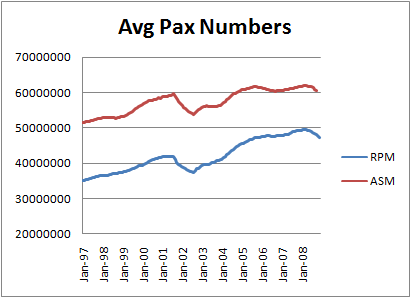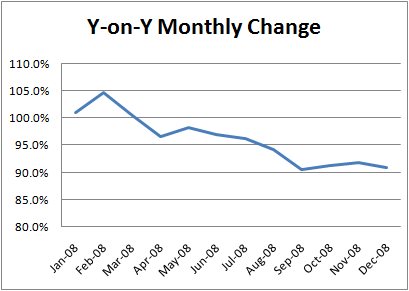Ten
Reasons Why
Fewer People are Flying
Air travel is down by almost 10% - is
this due to the economy or something else?
|
|
If passenger numbers
continue to drop at an almost 10% year-on-year rate, empty
airport gates will become increasingly common.
Are the airlines correct to blame this reduction on the
economy?
Part one of a three part
series on why fewer people are flying - please
also visit
1.
Facts, figures, fares and fees
2. Full and fewer Flights, better alternatives
3.
The total unpleasantness of air travel today |
The airlines blame the dropping
number of passengers on the tough economic conditions at
present. But this reduction in air travel started before the economy
'nose-dived' - and, let's be less histrionic.
The economy shrunk a barely noticeable 0.5% in the third
quarter - hardly a 'nose-dive' at all, while air travel dropped by
more than ten times that
amount.
Although the airlines are
masters at blaming everyone but themselves for every successive
problem they encounter (and have you noticed that the last
decade seems to have been non-stop problems for the airlines?), let's look carefully at why air travel
numbers are down.
Article Update Summary
This article was revised on
15 January 2009 to incorporate the latest statistics released
from the US Bureau of Transportation Statistics. These
statistics - for October 08 - simply extend the trends of the
preceding months and in no way alter the reasoning or
conclusions presented herein; if anything the tend extension
reinforces them.
Background Facts and Figures
It is difficult to easily
spot trends
in air travel numbers, due to the very seasonal
nature of air travel, which makes a simple plotting of month to
month numbers meaningless. More people travel in summer
months, and if there's a month with a major holiday featured (eg
4 July, Thanksgiving, Christmas/New Year) travel numbers are
massively different to the quiet numbers in the months before
and after.
Traditionally, the measure
used to track the rise or fall in passenger numbers is therefore
to compare passenger numbers each month with the same month the
previous year.
Using this method, we see
that for the period from October 06 through March 08 there was
an unbroken period of monthly increases in passenger numbers.
And for the broader 67 month period from September 02 through
March 08, passenger numbers increased in all but four of those
months, with the four months of decrease being trivial decreases
typically of less than 1% and never more than 1.6%. In
other words, there has been an extended and very positive period
of overall growth in air travel over the last six plus years.
This growth extends even
further into the past. A Department of Transportation data
series dating back to 1996 shows that for the 56 months between
January 1997 and August 2001 only four of the months did not
show a year-on-year growth, and again those four months had
trivial (typically 1% reductions), quickly expunged by the
positive months that followed.
The short-term 'blip' caused
by the 9/11 terrorist attacks took about two and a half years
for passenger numbers to return to and exceed the numbers prior
to September 2001. Viewed on a time scale from 1996
through 2008, the Sept 2001 temporary drop in passenger numbers
is merely a short term blip on an otherwise steady growth in
passenger numbers.
In theory, this record of
steady growth is one that most industries would dearly love to
embrace. So where's the problem?
The current contraction started in April 08, and since then, each month has shown a
reduction in passenger numbers compared to the previous year,
making now for a nine month unbroken period of market
contractions. With the exception of the post-9/11 period,
this has never happened before (the longest period before was a
three month period in 2006, with trivial 1.4%, 0.8% and 1%
reductions). And whereas the occasional
poor month in the past would show perhaps a 1% contraction, the
last nine months have been showing much larger contractions, and
it further appears that the month-on-month contractions are
increasing in size.
Here's a chart showing
passenger numbers. To eliminate the month to month swings
and to show trends, it is a rolling twelve month average.
RPM means 'Revenue Passenger Miles' and related to the total
number of paid miles flown by passengers on domestic flights in
the US. ASM means 'Available Seat Miles' and shows
the total available capacity of the airlines during the same
time period :

Note that because this chart
uses a 12 month rolling average, the impacts of the last few
months of contraction are not shown so vividly.
To
highlight the changes, here's a chart that shows, for each month
of 2008, its change compared to the same month in 2007 (note
that Nov is my estimate and Dec is an industry
estimate - official data has not yet been received).

The purpose of the preceding
information is to explain the nature of the problem and to put
it into perspective. There is no doubt that passenger
numbers are indeed falling appreciably, and there is no doubt
that this is more than just a passing random statistical
variation.
But what there seems to be
doubt about is the reason for these changes.
(Note - all charts use
the excellent data offered by the
US Bureau of
Transportation Statistics, except where otherwise noted.)
Reason 1 : Higher
Airfares Mean Fewer Travelers
Is this obvious, or what?
Basic economics - and common sense - tells us that if you
increase the price of something, you'll sell less of it.
And when it comes to increasing prices, the airlines are masters
of mismanagement.
Most companies seek to
adjust their prices only rarely, so as to convey an impression
of stability in their product and its price/value. But
during a single twelve month period between summer 2007 and
summer 2008, the airlines attempted to increase their fares 30
times (with 20 of their increases actually succeeding).
Not only has this genuinely
increased the cost of air travel, but it has massively
publicized the increasing costs, and gives the traveling public
the impression of an out-of-control escalation in the cost of
air travel. Other than gas, do you know of any other
product or service that has increased its pricing so much and so
often?
And - let's think about gas
pricing. Sure, gas pricing changes, sometimes on a daily
basis. But it goes both up and down, whereas, after the 30
attempted price rises in a single year, there surely haven't
been a matching number of price drops since the 2008 summer,
even through fuel prices (the excuse for the 30 price increase
attempts) are now way below their levels of summer 2007, and
less than a third of what they were in summer 2008.
And the price we see on the
billboard at the station is the price we pay - there are no
hidden surcharges or extra fees.
The airlines have managed to
harm themselves three different ways here.
-
Firstly, they've subjected us
to 'the death of a thousand cuts' by constantly aggravating us
with price rises averaging once every two weeks.
-
Secondly, they truly have
increased the cost of air travel at a rate greater than the rate
of inflation, with a commensurate drop in
travel numbers.
-
Thirdly, they've offended
our sense of fair play by not matching the price rises - which
in part we all grudgingly understood and accepted due to rising
oil prices - with price
drops now that their reason for increasing their fares has
vanished. In cases where they have reduced their fuel
surcharges, they've simply taken the fuel surcharge amount and
added it to the base fare, so that the amount we pay remains the
same. How cynical is that, and how stupid do they think we
are not to notice?
The bottom line - higher
airfares (and the massive new fees) have caused a reduction in
passenger numbers.
Reason 2 : All the Nasty
Extra Fees Discourage Passengers
It is now possible to pay
more to an airline to transport your luggage than you pay to
travel yourself. If you think that is fair (or even
sensible) then I'll guess you're an airline executive.
Most of us
passengers/customers think it outrageous that it is cheaper to
fly a 240lb passenger, complete with amenities and frequent
flier miles, than it is to place 120lbs of luggage in the hold.
That's not the only
outrageous fee. Do you know of a single
other industry that sells you something, and then adds an extra
fee when you actually choose to buy the product from them?
The airlines will charge you up to $35 to phone their
reservations center and buy a ticket - at full price - from them.
Fees are now commonly
charged by most airlines for :
-
Phone Reservations
-
A second piece of luggage
-
A first piece of luggage
-
Even more for luggage
weighing more than 50lbs
-
Even more for luggage larger
than standard size
-
Note these luggage fees
are accumulative - you can end up paying all three fees -
the fee for a piece of standard luggage (up to $25), for
overweight (up to $150) and oversize (up to $360) - and
these fees are each way, not roundtrip.
-
Advance seat selection
-
Premium for 'good' seats
-
Early boarding fee
-
Alcoholic drinks
-
Non-alcoholic drinks
-
Meals
-
Snacks
-
Standby
-
Curbside checkin
-
Unaccompanied minor
-
Traveling with a pet
-
Pillows and blankets
-
Changing your flights
-
Cancelling your flights
But wait, there's more.
Spirit Airlines was fined by the Department of Transportation in
December 08 for some even more imaginative fees that it added to
its tickets without properly disclosing in advance :
-
A 'natural occurrence
interruption fee' of $2.50, designed to cover the airline's
costs of refunds when it has to cancel flights due to bad
weather
-
An 'international service
recovery fee' of $8.50 to cover the costs the airline pays
to foreign governments to allow it the right to fly over
their territories
-
A 'passenger usage fee' of
$7.90; subsequently renamed as a 'convenience fee' and
reduced to $5.00, for all tickets not purchased at an
airport ticket counter
Not only are the airlines
pricing themselves out of existence, but they're offending our
sense of fairness in the process, thereby accelerating the
alienation between their customers and themselves.
Part one of a three part
series on why fewer people are flying - please
also visit
1.
Facts, figures, fares and fees
2. Full and fewer Flights, better alternatives
3.
The total unpleasantness of air travel today
Related Articles, etc
|
If so, please donate to keep the website free and fund the addition of more articles like this. Any help is most appreciated - simply click below to securely send a contribution through a credit card and Paypal.
|
Originally published
9 Jan 2009, last update
30 May 2021
You may freely reproduce or distribute this article for noncommercial purposes as long as you give credit to me as original writer.
|

